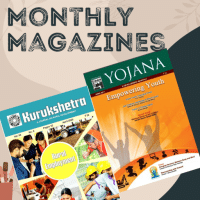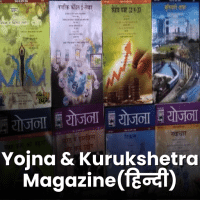Current Affairs Exam > Current Affairs Questions > In India’s context, which of the follow...
Start Learning for Free
In India’s context, which of the following statements is correct regarding heatwaves?
- a)The eastern and western coasts of India are most severely affected regions by heat waves so far.
- b)Heatwaves are traditionally found in Madhya Pradesh, Andhra Pradesh, Karnataka and Tamil Nadu.
- c)The India Meteorological Department (IMD) classifies heat waves according to regions and their temperature ranges.
- d)A heatwave is declared in the hilly area when the actual maximum temperature reaches at least 40°C.
Correct answer is option 'C'. Can you explain this answer?
Most Upvoted Answer
In India’s context, which of the following statements is correct...
- A heatwave is a period of abnormally high temperatures, more than the normal maximum temperature that occurs during the summer season in the North-Western and South Central parts of India.
- The India Meteorological Department (IMD) classifies heat waves according to regions and their temperature ranges. Hence, option C is correct.
- Recently, a study has found a spatial shift of heatwaves in India, now occurring in new regions in the country.
- It also added that the eastern and western coasts, which are currently unaffected by heatwaves, will be severely impacted in the future. Hence, option A is not correct.
- Also, heatwaves were found in southern Madhya Pradesh, Andhra Pradesh, Karnataka and Tamil Nadu, where they would traditionally not take place. Hence, option B is not correct.
- The heatwave is considered when the maximum temperature of a station reaches at least 40°C for Plains and at least 30°C for Hilly regions. Hence, option D is not correct.
- An increase of 5°C to 6°C from the normal temperature is considered to be heat wave condition.
Free Test
FREE
| Start Free Test |
Community Answer
In India’s context, which of the following statements is correct...
, there are a variety of traditional clothing styles that are commonly worn. Some of the most well-known clothing styles include:
1. Sari: A sari is a long, unstitched garment that is draped around the body and typically worn by women. It consists of a length of fabric that is wrapped around the waist, with one end draped over the shoulder. Saris come in a wide range of colors, patterns, and fabrics, and are often intricately embellished.
2. Salwar Kameez: This is a popular traditional outfit worn by both women and men. It consists of a long tunic top called a kameez, worn over loose-fitting pants called salwar. The outfit is usually paired with a dupatta, a long scarf that is draped over the shoulders.
3. Lehenga Choli: This is a traditional outfit worn by women for special occasions such as weddings and festivals. It consists of a long, pleated skirt called a lehenga, paired with a fitted blouse called a choli. The outfit is often embellished with intricate embroidery, beadwork, or other decorative elements.
4. Kurta Pajama: This is a traditional outfit worn by men. It consists of a long, loose-fitting tunic called a kurta, paired with a comfortable pair of pants called pajama. The outfit is typically made from lightweight, breathable fabrics and is worn for both casual and formal occasions.
5. Dhoti: This is a traditional garment worn by men. It is a long piece of cloth that is wrapped around the waist and legs, similar to a skirt. The dhoti is typically paired with a kurta or a shirt and is commonly worn for religious ceremonies or special occasions.
These are just a few examples of the traditional clothing styles in India. The country's diverse culture and regional variations also contribute to a wide range of other traditional clothing styles that are unique to specific regions or communities.
1. Sari: A sari is a long, unstitched garment that is draped around the body and typically worn by women. It consists of a length of fabric that is wrapped around the waist, with one end draped over the shoulder. Saris come in a wide range of colors, patterns, and fabrics, and are often intricately embellished.
2. Salwar Kameez: This is a popular traditional outfit worn by both women and men. It consists of a long tunic top called a kameez, worn over loose-fitting pants called salwar. The outfit is usually paired with a dupatta, a long scarf that is draped over the shoulders.
3. Lehenga Choli: This is a traditional outfit worn by women for special occasions such as weddings and festivals. It consists of a long, pleated skirt called a lehenga, paired with a fitted blouse called a choli. The outfit is often embellished with intricate embroidery, beadwork, or other decorative elements.
4. Kurta Pajama: This is a traditional outfit worn by men. It consists of a long, loose-fitting tunic called a kurta, paired with a comfortable pair of pants called pajama. The outfit is typically made from lightweight, breathable fabrics and is worn for both casual and formal occasions.
5. Dhoti: This is a traditional garment worn by men. It is a long piece of cloth that is wrapped around the waist and legs, similar to a skirt. The dhoti is typically paired with a kurta or a shirt and is commonly worn for religious ceremonies or special occasions.
These are just a few examples of the traditional clothing styles in India. The country's diverse culture and regional variations also contribute to a wide range of other traditional clothing styles that are unique to specific regions or communities.

|
Explore Courses for Current Affairs exam
|

|
Similar Current Affairs Doubts
In India’s context, which of the following statements is correct regarding heatwaves?a)The eastern and western coasts of India are most severely affected regions by heat waves so far.b)Heatwaves are traditionally found in Madhya Pradesh, Andhra Pradesh, Karnataka and Tamil Nadu.c)The India Meteorological Department (IMD) classifies heat waves according to regions and their temperature ranges.d)A heatwave is declared in the hilly area when the actual maximum temperature reaches at least 40°C.Correct answer is option 'C'. Can you explain this answer?
Question Description
In India’s context, which of the following statements is correct regarding heatwaves?a)The eastern and western coasts of India are most severely affected regions by heat waves so far.b)Heatwaves are traditionally found in Madhya Pradesh, Andhra Pradesh, Karnataka and Tamil Nadu.c)The India Meteorological Department (IMD) classifies heat waves according to regions and their temperature ranges.d)A heatwave is declared in the hilly area when the actual maximum temperature reaches at least 40°C.Correct answer is option 'C'. Can you explain this answer? for Current Affairs 2025 is part of Current Affairs preparation. The Question and answers have been prepared according to the Current Affairs exam syllabus. Information about In India’s context, which of the following statements is correct regarding heatwaves?a)The eastern and western coasts of India are most severely affected regions by heat waves so far.b)Heatwaves are traditionally found in Madhya Pradesh, Andhra Pradesh, Karnataka and Tamil Nadu.c)The India Meteorological Department (IMD) classifies heat waves according to regions and their temperature ranges.d)A heatwave is declared in the hilly area when the actual maximum temperature reaches at least 40°C.Correct answer is option 'C'. Can you explain this answer? covers all topics & solutions for Current Affairs 2025 Exam. Find important definitions, questions, meanings, examples, exercises and tests below for In India’s context, which of the following statements is correct regarding heatwaves?a)The eastern and western coasts of India are most severely affected regions by heat waves so far.b)Heatwaves are traditionally found in Madhya Pradesh, Andhra Pradesh, Karnataka and Tamil Nadu.c)The India Meteorological Department (IMD) classifies heat waves according to regions and their temperature ranges.d)A heatwave is declared in the hilly area when the actual maximum temperature reaches at least 40°C.Correct answer is option 'C'. Can you explain this answer?.
In India’s context, which of the following statements is correct regarding heatwaves?a)The eastern and western coasts of India are most severely affected regions by heat waves so far.b)Heatwaves are traditionally found in Madhya Pradesh, Andhra Pradesh, Karnataka and Tamil Nadu.c)The India Meteorological Department (IMD) classifies heat waves according to regions and their temperature ranges.d)A heatwave is declared in the hilly area when the actual maximum temperature reaches at least 40°C.Correct answer is option 'C'. Can you explain this answer? for Current Affairs 2025 is part of Current Affairs preparation. The Question and answers have been prepared according to the Current Affairs exam syllabus. Information about In India’s context, which of the following statements is correct regarding heatwaves?a)The eastern and western coasts of India are most severely affected regions by heat waves so far.b)Heatwaves are traditionally found in Madhya Pradesh, Andhra Pradesh, Karnataka and Tamil Nadu.c)The India Meteorological Department (IMD) classifies heat waves according to regions and their temperature ranges.d)A heatwave is declared in the hilly area when the actual maximum temperature reaches at least 40°C.Correct answer is option 'C'. Can you explain this answer? covers all topics & solutions for Current Affairs 2025 Exam. Find important definitions, questions, meanings, examples, exercises and tests below for In India’s context, which of the following statements is correct regarding heatwaves?a)The eastern and western coasts of India are most severely affected regions by heat waves so far.b)Heatwaves are traditionally found in Madhya Pradesh, Andhra Pradesh, Karnataka and Tamil Nadu.c)The India Meteorological Department (IMD) classifies heat waves according to regions and their temperature ranges.d)A heatwave is declared in the hilly area when the actual maximum temperature reaches at least 40°C.Correct answer is option 'C'. Can you explain this answer?.
Solutions for In India’s context, which of the following statements is correct regarding heatwaves?a)The eastern and western coasts of India are most severely affected regions by heat waves so far.b)Heatwaves are traditionally found in Madhya Pradesh, Andhra Pradesh, Karnataka and Tamil Nadu.c)The India Meteorological Department (IMD) classifies heat waves according to regions and their temperature ranges.d)A heatwave is declared in the hilly area when the actual maximum temperature reaches at least 40°C.Correct answer is option 'C'. Can you explain this answer? in English & in Hindi are available as part of our courses for Current Affairs.
Download more important topics, notes, lectures and mock test series for Current Affairs Exam by signing up for free.
Here you can find the meaning of In India’s context, which of the following statements is correct regarding heatwaves?a)The eastern and western coasts of India are most severely affected regions by heat waves so far.b)Heatwaves are traditionally found in Madhya Pradesh, Andhra Pradesh, Karnataka and Tamil Nadu.c)The India Meteorological Department (IMD) classifies heat waves according to regions and their temperature ranges.d)A heatwave is declared in the hilly area when the actual maximum temperature reaches at least 40°C.Correct answer is option 'C'. Can you explain this answer? defined & explained in the simplest way possible. Besides giving the explanation of
In India’s context, which of the following statements is correct regarding heatwaves?a)The eastern and western coasts of India are most severely affected regions by heat waves so far.b)Heatwaves are traditionally found in Madhya Pradesh, Andhra Pradesh, Karnataka and Tamil Nadu.c)The India Meteorological Department (IMD) classifies heat waves according to regions and their temperature ranges.d)A heatwave is declared in the hilly area when the actual maximum temperature reaches at least 40°C.Correct answer is option 'C'. Can you explain this answer?, a detailed solution for In India’s context, which of the following statements is correct regarding heatwaves?a)The eastern and western coasts of India are most severely affected regions by heat waves so far.b)Heatwaves are traditionally found in Madhya Pradesh, Andhra Pradesh, Karnataka and Tamil Nadu.c)The India Meteorological Department (IMD) classifies heat waves according to regions and their temperature ranges.d)A heatwave is declared in the hilly area when the actual maximum temperature reaches at least 40°C.Correct answer is option 'C'. Can you explain this answer? has been provided alongside types of In India’s context, which of the following statements is correct regarding heatwaves?a)The eastern and western coasts of India are most severely affected regions by heat waves so far.b)Heatwaves are traditionally found in Madhya Pradesh, Andhra Pradesh, Karnataka and Tamil Nadu.c)The India Meteorological Department (IMD) classifies heat waves according to regions and their temperature ranges.d)A heatwave is declared in the hilly area when the actual maximum temperature reaches at least 40°C.Correct answer is option 'C'. Can you explain this answer? theory, EduRev gives you an
ample number of questions to practice In India’s context, which of the following statements is correct regarding heatwaves?a)The eastern and western coasts of India are most severely affected regions by heat waves so far.b)Heatwaves are traditionally found in Madhya Pradesh, Andhra Pradesh, Karnataka and Tamil Nadu.c)The India Meteorological Department (IMD) classifies heat waves according to regions and their temperature ranges.d)A heatwave is declared in the hilly area when the actual maximum temperature reaches at least 40°C.Correct answer is option 'C'. Can you explain this answer? tests, examples and also practice Current Affairs tests.

|
Explore Courses for Current Affairs exam
|

|
Signup for Free!
Signup to see your scores go up within 7 days! Learn & Practice with 1000+ FREE Notes, Videos & Tests.


























